August 2021
Monthly Archive
Sat 7 Aug 2021
Taken from the Murania Press website:
The award-winning journal of adventure, mystery, and melodrama is back! After a two-year absence Blood ‘n’ Thunder returns as a book-length Annual, its 264 pages crammed with articles, illustrations, and fiction reprints. As always, the emphasis is on pulp magazines, vintage Hollywood movies, and Old Time Radio drama.

The Annual’s first section is a centennial tribute to the legendary detective pulp Black Mask, which celebrated its 100th birthday last year (an event planned for recognition in the canceled Spring 2020 issue of BnT). In addition to a history of the Mask, our tribute includes two reprinted articles from old writers’ magazines: a 1929 issue analysis by literary agent August Lenniger and a 1934 feature on pulp fictioneering by the Mask‘s most famous editor, Joseph T. “Cap†Shaw.
Also, Will Murray profiles aviation-pulp writer George Bruce (one of the few pulpsters to hit the big time as a Hollywood screenwriter); Tom Krabacher discusses the fantasy-adventure novels written by Spider scribe Norvell W. Page for Unknown; Denny Lien examines the 1936 one-shot pulp featuring Flash Gordon; Gilbert Colon compares the prose and filmed versions of H. P. Lovecraft’s classic yarn “Dreams in the Witch-Houseâ€; Matt Moring reveals the true identity of enigmatic pulpster “W. Wirtâ€; and Sai Shanker offers a history of the Butterick Company, the New York dress-pattern company that published Adventure, Romance, and Everybody’s magazines.
Additionally, Will Oliver covers the abortive Weird Tales radio show and a later attempt at supernatural horror, The Witch’s Tale. And there’s a lengthy excerpt from the new book by Martin Grams and Terry Salomonson on the creation and early development of the Lone Ranger radio program. BnT editor-publisher Ed Hulse contributes well-researched essays on the 1929 film adaptation of A. Merritt’s Seven Footprints to Satan, the 1943 Republic serial Secret Service in Darkest Africa, and the early career of well-regarded “Bâ€-movie director George Sherman.
Finally, the Annual reprints “Mountain Man,†the 1934 first installment in Robert E. Howard’s hilarious Western short-story series featuring Breckinridge Elkins.
PRICE INCLUDES SHIPPING TO BUYERS IN THE U.S. ONLY. INTERNATIONAL BUYERS MUST CONTACT US FIRST TO DETERMINE ADDITIONAL SHIPPING COSTS.
Fri 6 Aug 2021
Posted by Steve under
Reviews[4] Comments
RICHARD HELMS – Brittle Karma. Eamon Gold #3. Black Arch Books, trade paperback original, 2020. A small portion of this book appeared in Ellery Queen Mystery Magazine as the short story “The King of Gonna,†May-June 2018. Winner of the Shamus award in 2021, for Best Original PI Paperback.
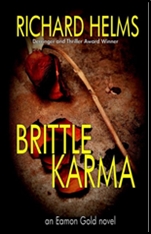
It isn’t because he’s a lot more flush with cash than usual that San Francisco PI Eamon Gold turns down a would-be client at the beginning of Brittle Karma. It’s because he doesn’t want to get involved with Abner Carlisle, a convict just released from prison after thirty years of nearly solitary confinement. Gold thinks that Carlisle wants him to find the latter’s former partner in crime – an armored car holdup that went wrong – and with thirteen million dollars that’s never been found, Carlisle’s intentions don’t need a lot of thinking to figure out.
More than that, Eddie Rice disappeared with Carlisle’s daughter, and when I say disappeared, I mean without a trace.
Having shoved Carlisle off toward another PI in town, Gold thinks that that’s the end of the matter, but when the man’s body turns up dead, the local police get very very interested, and Gold decides to start looking for Eddie Rice in earnest, first on his own, then on behalf of a paying client, the new husband of the former wife of Abner Carlisle.
If all this sounds complicated, it is, and I hope I’ve explained it to you all correctly. On the other hand, Richard Helms is a pretty good writer, and he tells the tale crispy and cleanly.
It takes a lot of legwork on Gold’s part to straighten everything out, hampered as he is throughout the book recovering from a stab wound in his leg (from a ballpoint pen) that happens early on (working another case). There are a couple good twists in the telling, and if you catch on to both before I did, maybe you ought to be a writer yourself.
This is somewhat of a rare item these days, a PI novel with a protagonist who’s basic and solid, with no strange behavioral habits to make him stand out in a crowd. He has a girl friend named Heidi who’s there for him whenever he needs a little R&R, but other than that, she has no major role to play in the story.
Gold is good for a quip every once in while, but those every once in while’s are just that, never coming close to overburdening the reader with them.
Meat and potatoes, that’s all. I liked this one.
Thu 5 Aug 2021
A QUIET LITTLE NEIGHBORHOOD, A PERFECT LITTLE MURDER. NBC, Made-for-TV, 1990. Teri Garr, Robert Urich, Susan Ruttan, Florence Stanley, Tom Poston, Jeffrey Tambor, Gail Edwards. Director: Anson Williams.
I agree, it’s a corny title, and if you don’t, it’s still a mouthful, and did you see who the director is? Anson Williams will never live down his role as Potsie on Happy Days. To tell you the truth, though – and you were waiting for me to say this, weren’t you? – I enjoyed this movie.

There have been quite a few mystery novels published in the last couple of years that have taken place in the suburbs, with bored housewives and/ or widows or widowers (or combinations thereof) doing the jobs solving mysteries they can’t convince the conventional authorities to do that they should be doing.
And once a trend begins, can TV be far behind? When a newly married couple – committed activists both – move from the big city, inevitably but inexorably, they find themselves settling in and – while they both deny it – becoming (!) yuppies. Not to mention being parents of a three month old daughter. What brings a rekindled degree of excitement to the life of the wife is a conversation she overhears on the baby’s kiddie-com – a clown with a large red lightbulb for a nose. The clown is also a radio transmitted, sending baby cries to the parents’ room, or wherever the second clown is located.
And the conversation concerns a murder about to be committed. Marsha, the wife (Teri Garr) somehow overhears it, but she cannot convince her husband Ross (Robert Urich) or the police detective (Alex Rocco) that she is not simply going bananas. Urich, who used to play Spenser, is also very good at pretending to be thickheaded, which is just exactly what his part requires.
Otherwise, this has about the right amount of mystery and suspense, mixed with more than enough comedy, and a little bit of detection as well. I think the bit about Marsha selling housewares door-to-door to aid in her sleuthing activities has been swiped from somewhere else, however, and I don’t really see Tom Poston (one of the two main suspects) as a killer, not that I’m saying he was, in case this movie is ever rerun again, as it surely will be. (He’s described here by one of the other characters, as a “Mr. Potato Head,†and that’s as apt a description of the man and the parts he played as I’ve ever heard.)
– Mildly revised from Mystery*File 26, December 1990.
Wed 4 Aug 2021
Posted by Steve under
Reviews[7] Comments
REVIEWED BY DOUG GREENE:
VAL GIELGUD & HOLT MAXWELL – Death at Broadcasting House. Inspector Simon Spears #1. Rich & Cowan, UK, hardcover, 1934. US title: London Calling. Doubleday, hardcover, 1934. Film: Phoenix, UK, 1934; released in the US as Death at a Broadcast.
MAX AFFORD – The Dead Are Blind. Jeffery Blackburn #2. John Long, UK, hardcover. Ramble House, 2007.

These may be the first two books to remove someone from this Vale of Tears at a radio station; at least Gielgud and Marvell in Death at Broadcasting House say several times that it had not been done previously. Whatever the case, both books benefit greatly from their settings.
Gielgud was head of radio-drama at the BBC from the late 1920s through the early 1960s. The first murder in Death at Broadcasting House is dependent upon a knowledge of the studios and the corridors at the then new BBC headquarters in London, At bit player in a drama, “The Scarlet Highwayman,” is murdered in the middle of the performance. Fortunately, his dying words fit in so well with the plot of the play that no one interrupts the broadcast.
Enter Inspector Simon Spears of Scotland Yard, who is faced with a prickly collection of actors, directors, sound-effects men, and writers. A recording — a “blattnerphone” — of the play has been preserved, and Spears is able to identify the sound of a mysterious watch during the broadcast.
Other clues include a torn copy of the script, some misplaced gloves, and an old playbill, Finally, Spears identifies the murderer, who responds by flinging himself from the BBC’s roof, The detective is not particularly memorable, but he is quietly competent and, except for a ridiculous explanation of why the murderer leaves blackmailing letters behind, all the clues hang together.
Max Afford was an Australian radio dramatist and Production Manager who wrote several novels about Jeffrey Blackburn and Chief Inspector Read. Afford had a viscous writing style; perhaps this example from his earlier Death’s Mannikins will suffice:
Did the sinister business have its genesis in that ill-omened and bewilderingly coincidental plunge into space taken by the acidulous Miss Beatrice, when her crippled feet fouled the staircase at Rochester House and thus begin a grim chain of events that are, to this day, almost unparalleled in criminological history?
It is tempted to reply, “who cares?”, and toss such a book aside, but it’s worth swimming upstream through Afford’s prose to get to his ingenious plots.
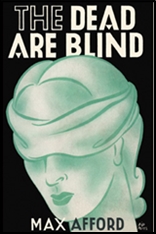
And The Dead Are Blind is certainly ingenious. As in Death at Broadcasting House, the murder occurs in the middle of a broadcast, but this time it is an impossible crime, as it is proven that those in the same studio could not physically have been responsible.
The plot has many elements, including a clever scheme of sending messages to criminals by hiding key words in the script, an elderly aunt who does not die conveniently, film actors, poisons, and an exceptionally clever solution.
Jeffrey Blackburn occasionally comes close to the superciliousness of Philip MacDonald’s Anthony Gethryn, who may be the most annoying of all fictional detectives. When Blackburn talks to himself, he uses such language as:
The intellect must be atrophying. God knows I’ve blundered before, but never to such inglorious depths as these! Is this to be my uncelebrated Waterloo — the one case from which Mr. Blackburn creeps away humbled and ashamed, to wince when it is mentioned and blanch at the recollection?
And when he arrives at the solution, he exclaims to his roommate Inspector Read:
For lo, the winter is past, the rain is over and gone; the flowers appear on the earth; the time of singing birds is come and the voice of the turtle is heard in our land!
But unlike Philip MacDonald, Afford could find such effusions funny. Read responds, “The voice of the imbecile is heard in my bedroom,” And imbecile or not, Blackburn is a good detective.
Both Death at Broadcasting House and The Dead Are Blind belong with such books as Sayers’ Nine Tailors in which plot is perfectly integrated with setting.
– Reprinted from The Poison Pen, Volume 6, Number 1 (Spring 1984). Permission granted by Doug Greene.
Tue 3 Aug 2021
Posted by Steve under
Reviews[2] Comments
TAYLOR McCAFFERTY – Pet Peeves. Haskell Blevins #1. Pocket, paperback original; 1st printing, October 1990.
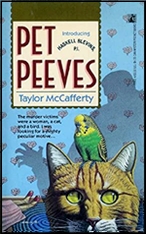
I liked the first line. It’s not quite as good as the one l quoted from one of Bill Crider’s books a couple of issues ago, but it sets the tone pretty well, and here it is: “It’s tough being a hard-boiled detective in a small town.” The small town as a case in point being Pigeon Fork, Kentucky, and the PI who is telling the story is Haskell Blevins.
Unfortunately, Blevins, who resembles Howdy Doody in appearance — all those freckles — is not nearly as hard-boiled a detective as he thinks he is. It is even hard to believe he spent eight years with Homicide in Louisville, as McCafferty pretty much aims for laughs in this, Blevins’ first recorded adventure.
And she succeeds, for the most part, but unlike Bill Crider’s books, you are laughing at her characters, not with them. I don’t think there is one of the several inhabitants of Pigeon Fork that I would ever come to think of as a friend. There is the inevitable town bully, the town drunk, the town busy-body, the almost senile Grampap, the morose sheriff who resents it when Haskell starts getting threatening notes, while he, the sheriff, never got one, and so on.
The case itself is the strange murder of Grammy (Grampap’s wife), pets, a cat and a parakeet named Sweety-bird. For all of book’s length (216 pages), there is only one clear-cut clue to the murderer, and that is all that Haskell needs to solve the case. All the rest is fooferaw, hillbilly style. (Amusing fooferaw, but still fooferaw.)
– Slightly revised from Mystery*File 26, December 1990.
The Haskell Blevins series —
1. Pet Peeves (1990)
2. Ruffled Feathers (1992)
3. Bed Bugs (1993)
4. Thin Skins (1994)
5. Hanky Panky (1995)
6. Funny Money (2000)
Mon 2 Aug 2021
Reviewed by David Vineyard:
Two Annoying TV Detectives at Work

THE CASE OF THE THE DANGEROUS ROBIN. “Zippered Notebook.” Syndicated, Ziv Productions. 20 December 1960 (Season 1, Episode 10). Rick Jason, (Robin Scott), Jean Blake. Guest Cast: Susan Cummings, Walter Klemperer. Directed by James Goldstone.
THE CHEVY MYSTERY SHOW. “Enough Rope.” NBC, 31 July 1960 (Season 1, Episode 10). Host: Walter Slezak. Cast: Richard Carlson, Joan O’Brian, Bert Freed. Teleplay: William Link and Richard Levinson. Director: Don Richardson.
Following the success of Richard Diamond and Peter Gunn a number of cool detectives tried their wares on the small screen, a few interesting like Johnny Staccato and most missing the boat all around like The Case of the Dangerous Robin (that title is moronic).

The dangerous Robin is international insurance investigator Robin Scott (Rick Jason), a slick buttoned-down sleuth with a regular girl friend (unlike Lola Albright she can’t sing and the byplay is about as sexy as spending Saturday night home with your family).
Seems Robin’s girl plans to cook him a nice meal, but he has been called out of town, to Belgium, where scientific notebooks his company insures have been stolen from a scientist working for Werner Klemperer and trying to evade his bosses man-eating wife.
We get a few stock shots of Antwerp, but the footage Jason is in is strictly Southern California architecture and fauna. They do throw a few foreign cars in though and a couple of accents and a phony name on a hotel front.

Jason, who did his best work as a regular on Combat, is flat here, delivering his lines in what I am sure everyone thought was Craig Stevens Peter Gunn style cool, but which seems almost zombie like even when Robin is being shot at. (I was rooting for the assassin by this point.)
You know you are in trouble when you wish it was Ray Danton starring instead.
Nice score by David Rose, but that and the titles are the only highlights.

It looks, sounds, and feels like amateur night at the dinner theater.
Robin’s technique is unique though. He just accuses everyone and annoys them until someone confesses. Which will bring us shortly to our next annoying sleuth.
“Enough Rope†appeared on The Chevy Mystery Show, hosted by Walter Slezak, and appears to have been done live on film, meaning it is pretty set bound and there is little sign of second takes, but it doesn’t quite have the same cachet as real live television. It’s done in color too, which also takes away from the effect.

You will quickly recognize “Enough Rope†as “Prescription Murder,” the pilot film for Columbo with Gene Barry a psychologist who commits the perfect murder, only to find it investigated by Peter Falk’s Lt. Columbo, the greatest annoying sleuth of all time.
Here Richard Carlson is Dr. Ryan Fleming who murders his wife with the help of his secretary mistress (Joan O’Brian mostly semi comatose) and Columbo is veteran character actor Bert Freed. Freed was always good, and often played frustrated cops (The Gazebo), but smart as his take on Columbo proves he is just another cop despite delivering some of the exact same dialogue that will shine in the hands of Peter Falk.

“Enough Rope†wasn’t brand new even then. It was originally written as a vehicle for Bing Crosby (likely inspired by his laid back private detective in Top O’ the Morning), but played on stage by Thomas Mitchell. I’m not even sure this was its first outing on television as it showed up later as a black and white episode of another anthology with Lou Jacobi as Columbo.
It’s hard to keep a good plot down, but until the magic of Peter Falk it pretty much managed to fail in every medium it appeared in.

For now these are available on YouTube if you want to see them. I can’t really say much for the Jason entry other than it is only twenty five minutes long and quickly over.
“Ropeâ€, despite the flaws of the format, is fairly good. Carlson was a capable actor, and like Gene Barry able to be sympathetic, arrogant, and evil all in the same take. Freed is pretty much himself as he was in most roles, but like good character actors that is what you want from them.
Once in a while in the episode, the plot crammed into fifty minutes, you get a little glimpse of Columbo, though you can’t help but see and hear Falk while watching, missing the cadences and quirks of his performance that made the character into what it became.

Unlike other Columbo episodes how he traps the killer in this one might even hold up in court if the defense wasn’t very good.
There is no real tie to these two save they are old television programs and I watched them the same day and thought it unusual both featured such annoying detective characters, both of whose success was blatantly based as much on their ability to annoy suspects as detect crime.
And to think Sherlock Holmes and Dr. Thorndyke wasted all that time on science and detection when they could just have accused everyone until someone breaks and tries to kill them.
Sun 1 Aug 2021
FIRST YOU READ, THEN YOU WRITE
by Francis M. Nevins
Does anybody still read F. Van Wyck Mason? I began buying his books in my teens and accumulated a generous assortment of them over time but read very few if any until recent years. His first name was Francis, his middle name was pronounced Van Wyke, and he was born in Boston in 1897, although some print and Web sources give the year as 1901, which strikes me as wrong because that would have made him 15 or 16 at the time the U.S. entered World War I, in which he is said to have served.

He spent most of his early years in Berlin and Paris, where his grandfather was U.S. Consul General, and didn’t learn English until he was in his teens. After graduating from Harvard in 1924 he started his own importing business and traveled the world purchasing antique rugs and other objets d’art. As a fiction writer he debuted in 1928, appearing in many pulps but most often in Argosy, which published several of his historical adventure serials with titles like CAPTAIN NEMESIS, CAPTAIN JUDAS, CAPTAIN RENEGADE, CAPTAIN REDSPURS and CAPTAIN LONG KNIFE.
As these titles unsubtly suggest, he was a military kind of guy, serving in Squadron A of the New York National Guard and later in the Maryland National Guard. He was also something of an athlete, his favorite sport being polo, a subject which crops up in many of his novels and stories. During World War II he put his writing career on hold and returned to the military, rising to the rank of Colonel and the position of chief historian on General Eisenhower’s staff.
After the war he returned to fiction writing and eventually moved to Bermuda, where in 1978 he drowned. He was probably best known for a string of gargantuan historical adventure novels, beginning with THREE HARBOURS (1938), STARS ON THE SEA (1940) and RIVERS OF GLORY (1942), but here we are interested in his early crime fiction — not on its merits but because, as we’ll see shortly, it had a huge influence on one of the giants of the genre.
***
His first novel, SEEDS OF MURDER (1930), introduces his series character Captain Hugh North, an officer in Army Intelligence but never seen in uniform and obviously intended as an American Sherlock Holmes. Appropriately enough, he has a Watson who, like the original, happens to be a medical man, a doctor named Walter Allan.
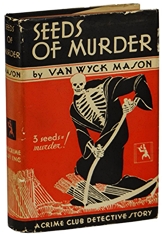
North is visiting with Allan at Hempstead, Long Island, when both men are invited to dinner at the palatial home of Royal Delancey, a former Philippine plantation owner who made a fortune during World War I and afterwards, back in the U.S., bought into a firm of stockbrokers. Delancey’s version of Toad Hall is hit by a savage storm before dinner can be served. Then one of his house guests, who is also his brokerage partner, is found dead in his bathroom, seemingly having strangled himself with a strong chain.
But why was his apparent suicide note written on a piece of paper a quarter-inch shorter than the other sheets on his desk, and how could he have reached the hook on which the chain was hung by standing on a wire-and-enamel wastebasket too flimsy to support his weight?
Even stranger, why were three mysterious seeds found on the bathroom floor, arranged in a precise triangle? North keeps his counsel and doesn’t dispute the police verdict of suicide, but before dawn the next morning Delancey himself is stabbed to death with an exotic dagger in his bedroom, and three more of those triangularly arranged seeds are lying beneath his chair.
Among the suspects are Delancey’s mistress, his abused young wife and her brother (both of whom are near broke after having entrusted him with their money), a former neighbor who had also lost heavily by investing with Delancey, and a sinister Filipino butler who perpetrates lines like “‘Scuse if I speak slow. Me no spik English ver’ well.â€
At times the novel veers close to silent-movie melodrama, especially at the action climax where North disguises himself as a gypsy and sets a trap for the murderer in front of a disused Russian Orthodox church. But, unlike most of the subsequent books in the long series, this one is a genuine detective novel, rife with complexities, clues, conundrums, the works.
Mason seems to know his Philippine background but ridiculous is the best word for his notion of an inquest, held in the Delancey living room and culminating with the coroner’s jury indicting two suspects. The novel isn’t as scrupulously fair as, say, an early Ellery Queen, and its politically incorrect portrayal of Filipinos and gypsies — oops, my bad, we’re required today to call them Roma — make it an unlikely candidate for revival in the 21st century.
***
THE VESPER SERVICE MURDERS (1931) begins much as SEEDS OF MURDER did, with North on vacation and staying with his Watson at the palatial home of a nabob, but the prosperous Massachusetts mill town they’re visiting may perhaps owe something to the Poisonville of Hammett’s RED HARVEST (1929), crooked politicians, fat sloppy cops and all.
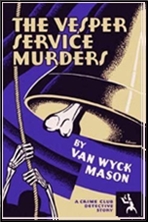
The city’s corrupt mayor is running for re-election against a Reform candidate who’s backed by North’s host, a wealthy old judge, and who’s courting his sponsor’s lovely daughter. After a tense conversation involving the judge, the rival candidates for mayor and a local businessman who’s also interested in the judge’s daughter, the mansion is visited by an old Army buddy of North’s, now a detective hired by the judge to investigate the current administration.
Within minutes after the conference has broken up comes a double murder, with the investigator shot dead on the drive outside the mansion and the mayor on the grounds close by, while the judge is conked on the head in his study and the mysterious message given him by his detective burned. The mayor leaves North with one of the reasons this book is historically important: a dying message.
The next morning, after another weird coroner’s inquest, held in the mansion and presided over by the state police, a bomb goes off in the house. North sends the injured judge and his daughter to their summer place in the forest a few hours away and continues to investigate, soon getting on the track of a mystery man known as Vesper who apparently controls the city.
Fearing for the judge’s life, North and Allan go by train to the hamlet of Deer Lake Junction, only to find the whole area menaced by a forest fire. And so on and on until the climactic shoot-out between North and Vesper, punctuated by lightning flashes and thunderclaps. Mason slathers on the melodrama with a trowel, displays his ignorance of German by adding umlauts to words like Oberleutnant and Sturm, and still labors under the SEEDS OF MURDER delusion that a coroner’s jury can indict someone for murder. On the other hand, he evokes the stifling heat vividly and handles two central clues with great subtlety.
No one would call VESPER SERVICE a classic but, as I said before, it’s of considerable historical value for the influence it exerted on one (or perhaps two) of the finest detective novelists of the Golden Age. Fred Dannay (1905-1982), who customarily did the plotting for the novels he and his cousin Manfred B. Lee (1905-1971) wrote under the byline of Ellery Queen, is known to have gotten many of his ideas from other novels, notably Conan Doyle’s THE VALLEY OF FEAR (1914), whose main plot device he adapted again and again in the early Queen books (1929-35).
Quite clearly he also drew on THE VESPER SERVICE MURDERS, which contains at least four elements familiar from the EQ canon. First and foremost is the one I mentioned before, the dying message theme, which the cousins first used in THE TRAGEDY OF X (1932, as by Barnaby Ross) and continued to employ for decades. Next comes the motif of color blindness, which recurs in Queen again and again (although Fred and Manny, who both smoked heavily as young men, never claimed as does the oculist in VESPER SERVICE that the disease can be caused by excessive tobacco).
Then come the clue of the train conductor’s ticket punch, which is central to THE TRAGEDY OF X, and the forest fire, which dominates THE SIAMESE TWIN MYSTERY (1933). Except perhaps for THE VALLEY OF FEAR, I suspect there’s no other book to which Queen is so indebted as THE VESPER SERVICE MURDERS.
***
Around this time it must have dawned on Mason that he couldn’t indefinitely continue the North series in its original configuration. After all, his protagonist was supposed to be a captain in the Army, and so far he’d had nothing but civilian detective cases with few military aspects.
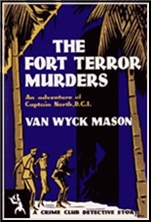
His creator made some stabs at addressing this problem in the third North novel, THE FORT TERROR MURDERS (1931), dropping Dr. Allan down the memory hole and swapping the stateside settings of the first two Norths for a more exotic locale. We are on the Philippine island of Luzon, and North, stationed in Manila, visits the isolated military outpost of Fort Espanto to play polo, although if he came with a team we see neither hide nor hair of any other player on his side.
At a dinner party hosted by the post’s commanding officer, North hears stories about a fabulous treasure hidden by Jesuit priests (who were expelled by the Spanish in 1767) somewhere in the monastery over which the original Fort Espanto was later built. The party is interrupted by a young Spaniard who announces that the treasure has been found.
North accompanies the colonel, his aide, several other officers and the four women in the dinner party as they go out in near pitch darkness to search the long deserted original fort. It should come as no surprise to any reader when the Spaniard is stabbed to death and the lieutenant who was working with him vanishes.
The next day brings another murder along with various incidents like North finding a cobra in his desk drawer. But the main intellectual thrust of the novel is not so much solving the murders as cracking the code leading to the treasure, a complex cipher devised by a diabolically clever Jesuit in the 1760s and involving a pair of unusual rosaries, the Latin text of the Our Father and the positions of two stars.
The reader of course is given no chance either to penetrate the code or to figure out who killed whom. On the plus side, the Philippine atmosphere seems to ring true and Mason doesn’t spare us the white racism: “These islands would be a great place if there weren’t any Filipinos on them,†North is told by a fellow officer.
But the multitudinous lieutenants and captains in the cast are a bit hard to tell apart and an inordinate number of them seem to be living in the post commander’s lavish house. For better or worse, FORT TERROR makes clear that the original version of North as a sort of soldierly American Holmes had become history.
In later novels Captain Hugh tackled various problems of international intrigue in exotic locales and did so well that he was promoted to Major and then to Colonel, nimbly leapfrogging over the intervening rank of Lieutenant Colonel. These books converted him from a Holmes-like figure to something of a prototype for James Bond and perhaps for James Atlee Phillips’ American secret agent Joe Gall. Will I tackle any of them in later columns? Dunno.
« Previous Page

















